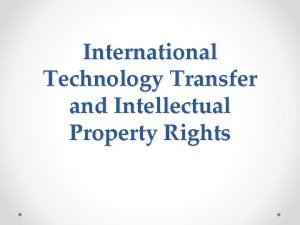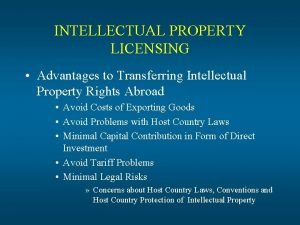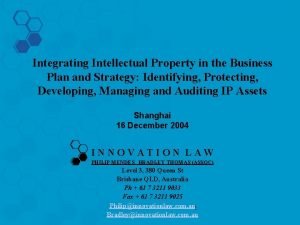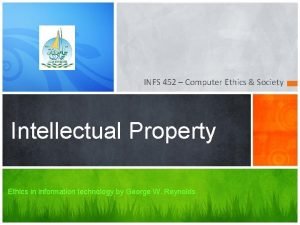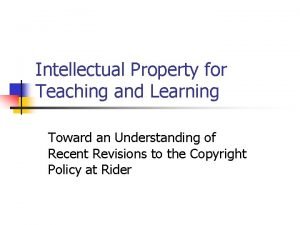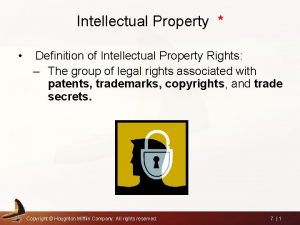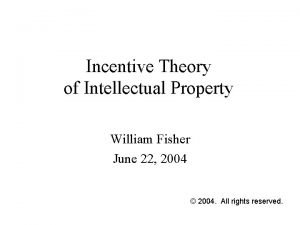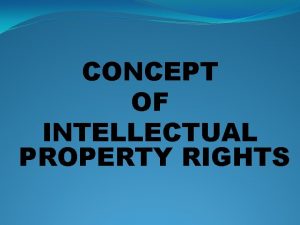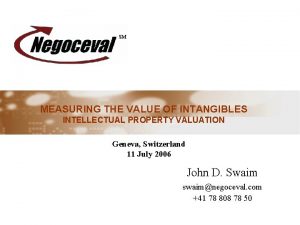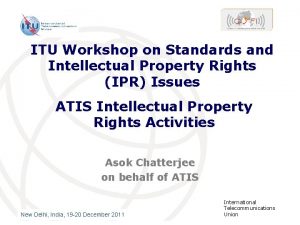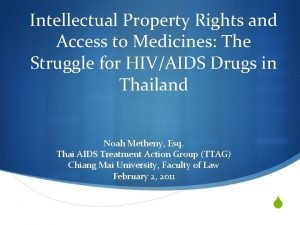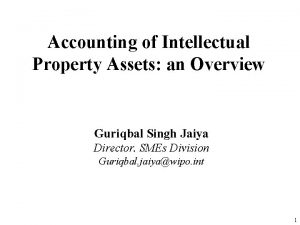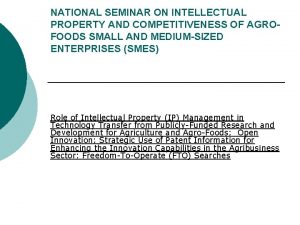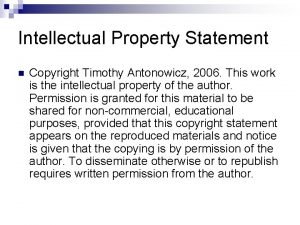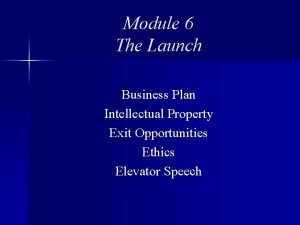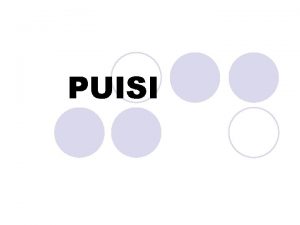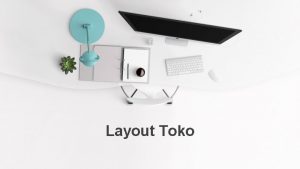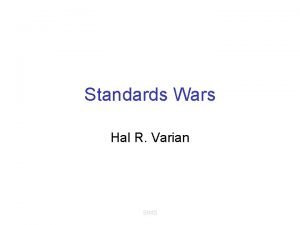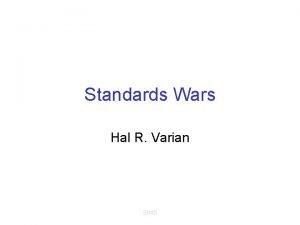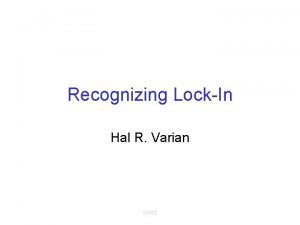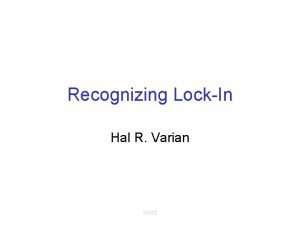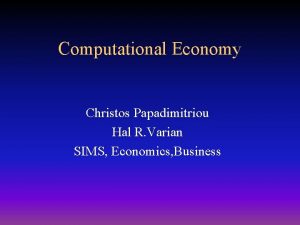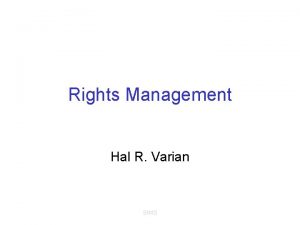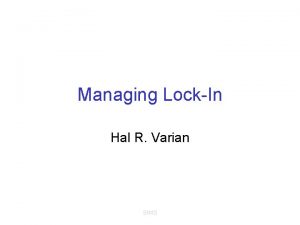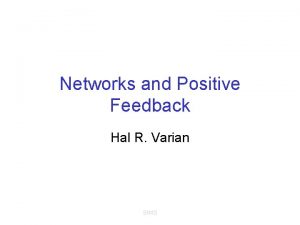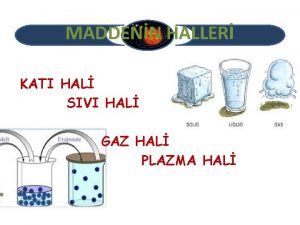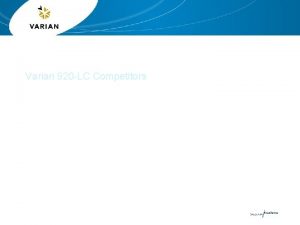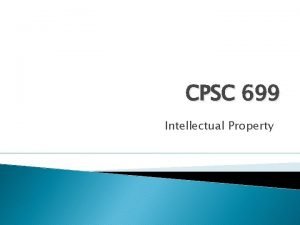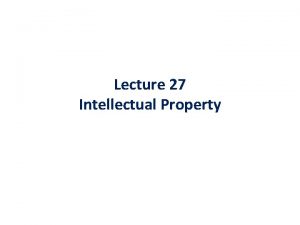Intellectual Property Hal R Varian SIMS Outline Types

























- Slides: 25

Intellectual Property Hal R. Varian SIMS

Outline • Types of intellectual property – Trademarks – Trade secrets – Patents – Copyright • Background + tech issues for each one SIMS

Trademark • Trademark – Identify a product or service – name, logo, etc. • Incentive to invest and maintain reputation • Legal issue: avoid consumer confusion – Is there an attempt to confuse or mislead? – Claim a trademark™ or register a trademark® • Only applies within a particular line of business • E. g. Apple computer, Apple music, Continental Airlines, Continental Tires, etc. – Abandonment or genericide • Use it or lose it • Aspirin is generic in US, not Canada • Requirement to enforce: owners don’t want you to “xerox a copy”, “photoshop a page”, “google someone” SIMS

Trademark issues • Domain name system – Cybersquatting: choose domain names that are trademarks: ATT. org, IBM. org. More TLDs. – ICANN’s Uniform Dispute Resolution Policy • Use of trademark terms in <meta> – Oppedahl & Larson v. Advanced Concepts – Playboy v Terri Welles • Use of trademark in keyword adv – Geico v Google: Not infringing to sell keyword “GEICO” to other advertisers – However, advertisers may not use trademark in infringing way – Europe sees things differently… SIMS

Trade secrets • Confidential method or process, which confers economic benefit, is kept secret • Unlimited life but easy to lose, no requirement to disclose as with patent – Someone else can file a patent on your trade secret and you can be sued for infringement! • Discovering trade secrets – Lawful methods (reverse engineering) • But: anticircumvention legislation for DRM systems – Unlawful methods • Espionage, theft, etc. – Anti compete clauses for workers? SIMS

Patents • Exclusive right to an invention for a limited amount of time in exchange for disclosure – File for patents in particular jurisdiction – Gives you a “license to sue” • Dimensions of a patent – Length – time of protection – Width – breadth of coverage – Height – standard of novelty SIMS

Patent length • Tradeoff – Monopoly price for k years – Then competitive price forever • Social cost to consumers of delaying low price • Profit to producers creates incentive to innovate – Optimal life of patent trades these two things off • It appears that 20 years isn’t unreasonable • In theory would like different years for different industries, but this is difficult to implement SIMS

Breadth of patent • Software patents – Ideas cannot be patented – Mathematical formulas and algorithms cannot be patented – But devices that use them can be patented – What’s the difference between implementing an algorithm in hardware software? Hardware is just “frozen software”. • Business process patents – Reverse auction – Rounding up when making change SIMS

Standard of novelty • Cannot be “obvious to someone skilled in the art” – But the person skilled in the art may be without a shred of creativity… – Perception of reduced patent quality in recent years – Particularly true in “software and process patents” where record of prior art is minimal • Amazon’s patent on “one click purchase” – Patent examiners are overworked and underpaid… SIMS

Examples of granted patents 4, 022, 227: Method of concealing partial baldness 5, 443, 036: Method of exercising a cat SIMS

Patent explosion SIMS Source: Bronwyn Hall

Explanations of 1986 patent explosion • According to Hall (2004)… – 1982 creation of Court of Appeals for Fed Circuit courts made patents more likely to be upheld – 1985 TI sues Japanese semiconductor firms and wins – 1986 Kodak-Polaroid decision on instant cameras: preliminary injunction to stop production + $1 B judgment [Vonage] SIMS

Patent arms race • If competitor sues you, you want patents in order to countersue • Leads to arms race in patents – Each side needs bargaining chips for settlements and/or cross licensing – Like cold war missiles • The big danger is the outsider (“nuclear terrorist”) who has nothing to lose SIMS

Patent thicket • May need to search thousands of patents – Very difficult to find all the relevant patents – Very easy to infringe • Holdup problem: search is a sunk cost – Once you do find patent holder, it may try to extract extortionary terms – Easier just to counterarm yourself with defensive patents SIMS

Examples of outsiders • Submarine patents – Deliberately draw out application process • Patent published long after application filed (Lemelson: 18 -39 year delay on machine vision patents) • Then demand license fees – Now no longer possible due to 18 month publication requirement • Patent trolls – Acquire portfolio which it never intends to put in production, but looks for infringers from whom troll demands a license • Research in Motion (Blackberry) v NTP, Inc. infringement case on wireless email – Perhaps $1 B in settlement + 9% royalty SIMS

Copyright • Motivation for copyright is in US Constitution: – “To promote the Progress of Science and useful Arts, by securing for limited Times to Authors and Inventors the exclusive Right to their respective Writings and Discoveries” • Originally 14 year term to American authors + 14 year renewal – US did not sign international copyright treaties until 1891 – temptation to free ride on English literature was too strong – What made the US sign in 1891? – Examples of developing countries SIMS

Piracy and per capita GDP SIMS

Growing complexity • Copyright act of 1909 – More works of authorship such as • Mechanical reproductions, performance rights, print rights, grand rights, etc. – Extended term to 28 years + 28 years • Further extensions – 1962: 47 years, 1978: 67 years, 1998: life of author + 70 years, 95 years for works for hire. Is that really a “limited time”? – Furthermore, extensions were applied retroactively! SIMS

Economics of extension • Value of the extra years is tiny – Only reason to do it was the retroactive extension! – What was original intent of the authors of the Constitution? • Supreme Court decision on Eldred case – “small number” logic SIMS

Other terms and conditions • Fair use – a defense against accusation of infringement. Issues: 1. the purpose and character of the use, including whether such use is of a commercial nature or is for nonprofit educational purposes; 2. the nature of the copyrighted work; 3. the amount and substantiality of the portion used in relation to the copyrighted work as a whole; and 4. the effect of the use upon the potential market for or value of the copyrighted work. SIMS

Other issues • Doctrine of first sale – Once you buy work, can do with it what you will • Libraries, used books – Can be set aside by legislation: in US cannot rent CDs, but you can rent DVDs • Home copying – Sony v Universal Studios, 1984 – VCR had substantial non-infringing uses (e. g. , time shifting) SIMS

Tradeoffs • Allowing some copying… – Makes work more valuable – But may reduce sales – I. e. , increases price, reduces quantity sold – Want to find optimal point… • Example – Academic journals and photocopying – News stories on the web SIMS

Problems with copyright • No central registry, search costs are high – Orphan works problem • Very long lifetime – Counterbalanced by strong fair use? • Impact of internet – Incidental copies – Thumbnails of photos: Kelly v Ariba Soft – Google v Perfect 10 SIMS

Google Library project • Digitize books – Show snippets as a result of searches [next slide] – Opt out by publishers • Assoc. of American Publishers filed law suit • Issues – Copying for purpose of allowing people to find works – Fair use (as with thumbnail images) – Transactions costs (opt out rather than opt in) – Hold up wrt licensing SIMS

SIMS
 Trade-related aspects of intellectual property rights
Trade-related aspects of intellectual property rights Secondary infringement
Secondary infringement Importance of intellectual property
Importance of intellectual property Intellectual property management definition
Intellectual property management definition Advantages of intellectual property
Advantages of intellectual property Example of intellectual property in business plan
Example of intellectual property in business plan Intellectual property in computer ethics
Intellectual property in computer ethics Right to intellectual property of teachers
Right to intellectual property of teachers Intellectual property definition
Intellectual property definition Theories of intellectual property william fisher
Theories of intellectual property william fisher Concept of intellectual property
Concept of intellectual property Intellectual property valuing
Intellectual property valuing Intellectual property rights
Intellectual property rights Intellectual property rights
Intellectual property rights Characteristics of intellectual property
Characteristics of intellectual property Discuss intellectual property frankly
Discuss intellectual property frankly Intangible inputs
Intangible inputs Intellectual property
Intellectual property Intellectual property statement
Intellectual property statement Intellectual property business plan example
Intellectual property business plan example Evalueserve intellectual property
Evalueserve intellectual property Discuss intellectual property frankly
Discuss intellectual property frankly At&t ecommerce
At&t ecommerce Hal yang diperhatikan dalam membuat puisi
Hal yang diperhatikan dalam membuat puisi Layout toko
Layout toko Hal-hal yang bisa diobservasi secara audial adalah… *
Hal-hal yang bisa diobservasi secara audial adalah… *


